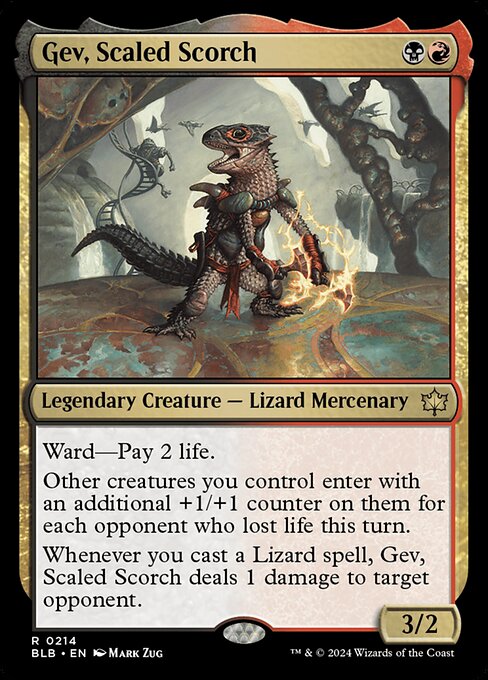
Image courtesy of Scryfall.com
Gev, Scaled Scorch and the Rise of Fan-Driven Card Design
Magic: The Gathering has a storied tradition of listening to its players, yet the Bloomburrow cycle marks a notable moment where fan input started to visibly tilt both flavor and function. Gev, Scaled Scorch stands as a vivid example of this dialogue in action: a two-mana, two-color legend whose presence on the battlefield feels like a cunning bargain with fate. The card’s design invites players to weigh risk, timing, and a little politics across the table—an invitation that fans helped shape long before it hit the gatherer UI. 🧙♂️🔥
At its core, Gev is a Legendary Creature — Lizard Mercenary with a lean mana cost of {B}{R}. In Bloomburrow, a set known for pushing edge-case interactions and bolder color identities, Gev’s color pairing is a deliberate tug-of-war between disruption (Black) and aggression (Red). The rarity—rare—signals that this design aims to be a meaningful centerpiece in a two-color, midrange shell rather than a trivial tempo drop. The artwork by Mark Zug captures a mercenary willing to walk through fire and debt alike, a thematic mirror to the card’s mechanics: control the flow of life totals, and your army grows more menacing with every opponent’s misfortune. 🎨⚔️
Ward as a Design Boundary and Narrative Echo
One of the most talked-about design features is the Ward ability: Ward—Pay 2 life. This isn’t just a tax; it’s a narrative hedge. Ward creates a soft strategic boundary, rewarding smart play while ensuring Gev doesn’t melt faces immediately in every matchup. Fans who advocated for “sticky, interactive threats” during playtesting found a home here: Gev punishes reckless swings and, at the same time, rewards players who think several steps ahead. Ward also nudges deck construction toward resilience—players begin factoring life-loss risk into both combat and noncombat decisions. It’s this subtle tension that elevates Gev from a neat stat-line to a card with staying power in formats where life totals and political calculus matter. 🧩
Kickstart Mechanics: The +1/+1 Counter Cascade
The next layer of fan-informed design appears in Gev’s triggered and static text. The ability “Other creatures you control enter with an additional +1/+1 counter on them for each opponent who lost life this turn” is a mouthful, but it’s a carefully curated concept. It creates a scalable payoff that responds to how many opponents are taking life-loss damage in a given turn, whether from Gev’s own presence or from other sources. The more life-flows are manipulated at the table, the bigger your board becomes on the backs of your adversaries. This design fosters a chaotic, but calculable, board state—perfect for multiplayer formats where shifting alliances and tempo games are the norm. It’s a direct nod to the community’s appetite for cards that reward multi-opponent play without devolving into pure “everybody lose life, everybody win” chaos. The result is a dynamic, sometimes jaw-dropping swing that feels earned instead of handed to a single player. 🔥💎
Meanwhile, the clause “Whenever you cast a Lizard spell, Gev deals 1 damage to target opponent” reinforces a subtle tribal flavor while providing a reliable burn motif that can punctuate turns. It’s a compact reminder that in a two-color system built around risk and retaliation, small triggers can tip the balance and keep players engaged. This kind of layering—tribal identity, direct damage, and a life-total-based scaling mechanic—has been a recurring theme in fan-inspired design thinking: give players a pathway to influence the outcome through choices, not just brute force. ⚔️
Designers often hear from players who crave cards that reward interaction and group dynamics. The interplay between Ward costs, life-loss pacing, and trigger-driven damage creates a feedback loop where players discuss not just what a card does, but how it feels to deploy it around a table full of shifting priorities. When fans see these ideas realized in a single card, their sense of ownership grows—this is the kind of feedback loop that keeps the game vibrant.
Beyond the numbers, Gev’s place in Bloomburrow tells a broader story: fan input doesn’t only shape flashy abilities; it nudges how a card sits in the metagame. The set’s identity, the magic of the red-black two-step, and the mercenary lore of Gev combine to create a card that feels narratively coherent and mechanically purposeful. It’s a reminder that card design is as much about tone and atmosphere as it is about a tidy stat line. And in a game where every card can redefine a draft or a commander table, that balance between flavor and function matters more than ever. 🧙♂️🎲
For readers building a workspace or a desk-side MTG corner, the fusion of design principles behind Gev can be a helpful compass. Consider how a single mechanic can ripple through your board states, your life totals, and your table talk. As fans continue to contribute their voices—whether through commentary during previews or through the longer-game feedback loop of social media and playtesting—the MTG design ethos benefits: more texture, more strategy, and more memorable moments that feel earned and not handed to us. 🔥
Product note: If you’re gearing up for a night of MTG with a themed desk or a streaming setup, this clean, responsive mouse pad makes a fine companion to long drafting sessions and content creation alike. It’s a practical nod to the tactile side of the hobby—where a well-made surface can spark a better game and a smoother schedule. Check it out here: Custom Rectangular Mouse Pad 9.3x7.8in White Cloth Non-Slip.
Product Spotlight
Custom Rectangular Mouse Pad 9.3x7.8in White Cloth Non-SlipMore from our network
- https://blog.digital-vault.xyz/blog/post/how-minimal-texture-shapes-design-psychology/
- https://blog.digital-vault.xyz/blog/post/top-buffs-and-synergies-for-summon-bahamut/
- https://blog.digital-vault.xyz/blog/post/how-to-write-release-notes-people-actually-read/
- https://crypto-acolytes.xyz/blog/post/day-trading-tokens-after-airdrops-practical-profit-tactics/
- https://transparent-paper.shop/blog/post/creating-minimalist-productivity-trackers-that-actually-work/